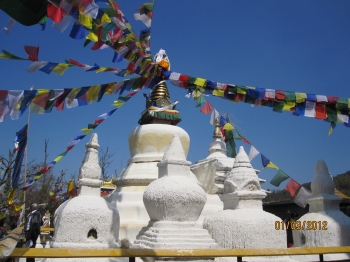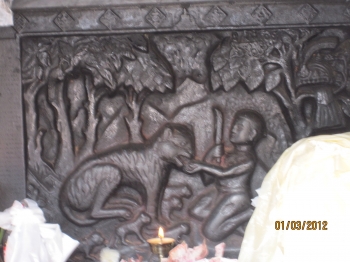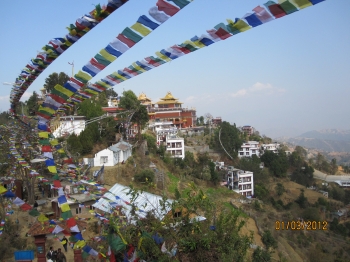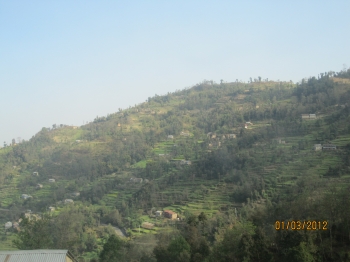Nepal is one of the most sought after destinations whether for pilgrimage or tourism. In February 2012, when I was studying at the University of Pune in India, staff from the Department of Pali arranged a trip to Nepal for us. We visited the holiest places, such as Lumbini, Gautama Buddha's birthplace, the ancient city of Kapilavastu, as well as temples and palaces in Kathmandu. Furthermore, we worshipped at the foremost pilgrimage site, Namo Buddha Mountain, and its Buddhist monastery. The combination of mythical themes of compassion of the Buddha's past lives endowed the mountainous terrain with a religious character that left a deep imprint on each of us, reminding us of the Bodhisattva's great sacrifice on his way to attaining Buddhahood.
We had embarked on a two and a half hour bus ride from Kathmandu to Namo Buddha Mountain. We passed through a number of villages located on the steep slopes of the high mountains. We saw the traditional way of life and villages retained a view of green interspersed with landscapes of plantation and natural vegetation. The region also is a sanctuary for a wide range of endangered species and wildlife, serving as the iconic cultural markers for the traditional local handcrafts and artifacts made for tourists.
On our ascent up the mountain, the chattering of birds and screeching of monkeys accompanied us from a distance. It was not long after, that the Namo Buddha Stupa came into sight and we began worshipping together. The legend goes that in one of Gautama Buddha’s past lives he was born as a prince. He and his two brothers were walking through the forest one day, when they saw a tigress with five cubs that she had given birth to. The newly born cubs were giving their mother a difficult time. Suffering from hunger, she could hardly move. The three brothers walked away with indifference, but the Bodhisattva among them decided to go back and, out of great compassion for the tigress, cut his flesh and gave it to her. When his brothers went back to look for him, they could only find his bones and hair. A stupa was built on top of these remains in commemoration of this event and is called the Namo Buddha Stupa. The mountain was also named Namo Buddha Mountain in remembrance of the story.
Afterwards, we continued our way up the mountain and reached the place where, as local tradition goes, was exactly the spot where the Bodhisattva sacrificed himself to the starving mother tigress. The sacrificial scene is also engraved in stone. According to several lamas, this is where the Bodhisattva donated his body, giving rise to the name in Tibet and the Himalayan regions of Takmo Lu Jin, meaning Generosity of Body for the Tigress. At present, thousands of pilgrims go there and hang clothes and flags on the branches of a tree to pay homage and for their protection. Later, we sat on the floor and Prof. Mahesh Deokar gave a brief lecture about the Jataka story and the mythical importance of the place. There was also a small stupa marking the den of the tigress.
On the Eastern side of the mountain, there stands Thrangu Tashi Tangtse Monastery of the Kagyu tradition, established by Khenchen Thrangu Rinpoche. The centre of the monastery houses the main building of the temple, a six-storey high construction decorated in the Indian style. It is a temple complex surrounded by many other small stupas and religious premises. The principal temple houses a bronze Buddha at the top, and the ceilings are adorned with mandalas from the great mantras. The walls are exceptionally ornate, covered in highly structured artwork, multi-colored carvings and wooden frames. At the main door of the temple large statues of religious figures give a feeling of an absolutely magical place. The picturesque landscape surrounding the temple makes it an ideal place for spiritual progress and religious experience.
The temple also contains secular structures for the benefit of the local populace, like a medical clinic, a school and a publication house, Dharmakara Publications, which contains resources for writing and translating, as well as a school which educates hundreds of young monks with a curriculum combining traditional and modern subjects such as mathematics, computer, English and Nepalei. There is also a monastic college which offers courses on Madhyamakay, Vinaya, Abhidharma, Perfections of Wisdom Sutras amongst many others.
Hundreds of monks from the Tibetan tradition go for preliminary monkhood practice. It is a three-year three-month retreat that involves the path of means (the six yogas of Naropa) and the path of liberation (the Great Seal). Students study and accumulte mantras for meditating on Chakrasamvara and other deities along with the practice of the guru yoga of Marpa which is passed on by great masters. It is mentioned on their website called Thrangu Tashi Yangtse Monastery, Namo Buddha Meditation and Education Centre:
If one creates in earnest the armor of bodhicitta,
It is like the treasury of space offering unlimited largesse.
For fortunate beings, this temple and all it contains
Are like the wondrous bursting forth of spring.
It is like the treasury of space offering unlimited largesse.
For fortunate beings, this temple and all it contains
Are like the wondrous bursting forth of spring.
Two lamas of the temple showed us around the temple and we witnessed various religious rituals and practices. Hundreds of monks sat together which gave us a spiritual insight into their piety. We took a group photo with many lamas with the temple as a backdrop.
We were excited to witness the Himalayas and some of us went to the top of the mountain. From there, the skyline of the Himalayas was prominently highlighted. For many of us, it was the first time we encountered the roof of the world and the sheer experience awed us. With the Himalayas on one side and the green hills on the other, the monastery is located in a strategic situation ideal for deeper meditative activities and progress.
Descending the mountain left us with a great memory as we walked along the path the Bodhisattva had traversed. His great sacrifice reminded us again to be generous towards all sentient beings, a practice which diminishes our egoistic tendency, and to work for the benefit of others. Although modern readers may take the story with a grain of salt, the place is a visible site to remind us of the Bodhisattva's journey towards enlightenment, which after thousands of years still inspires many people to practice.


















